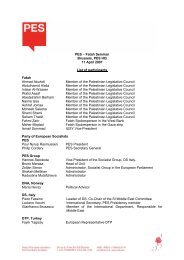Hedge funds and Private Equity - PES
Hedge funds and Private Equity - PES
Hedge funds and Private Equity - PES
You also want an ePaper? Increase the reach of your titles
YUMPU automatically turns print PDFs into web optimized ePapers that Google loves.
16<br />
In a very low interest-rate l<strong>and</strong>scape it is highly possible that the appetite of investors for risk<br />
<strong>and</strong> performance is bigger than risk-free instruments (typically bonds) can offer. This militates<br />
towards placing assets in HF <strong>and</strong> PEs.<br />
It looks like a vicious circle <strong>and</strong> it would be completely reversed in a high-interest rate scenario.<br />
This forms part of the discussion of systemic risks. Margin loans, securities lending <strong>and</strong> use of<br />
derivatives could lead to a total estimate on the enormous amount of leverage.<br />
In the HF industry the total debt including derivatives is something between 150% <strong>and</strong> 250%<br />
of HF single values, i.e. 2.0 – 3.3 trillion USD.<br />
Within this broad framework we see extreme cases. LTCM is well-known <strong>and</strong> CITADEL’s leverage<br />
amounted to 11.5 times. This is an example of groundbreaking ability to access capital markets<br />
for unsecured debt. The majority of HFs only have a few ways of boosting returns – <strong>and</strong> extensive<br />
leverage is one of the few – think LTCM.<br />
***<br />
The PE industry <strong>and</strong> its use of LBO in many ways has serious, direct consequences for the target<br />
companies: The PE <strong>funds</strong> usually co-finance an acquisition ¾ through leverage <strong>and</strong> ¼ its own<br />
assets. Thus the PE is acquiring a high return on the investment <strong>and</strong> at the same time pushing<br />
down debt on the target company.<br />
Extreme management fees <strong>and</strong> remunerations<br />
In the HF industry calculation of fees is based on two components: a 2% management fee<br />
charged on the total acquired asset plus a performance fee of 20%. The performance fee is typically<br />
determined as a share of the attained absolute return in excess of a specific hurdle rate.<br />
This calculation of fees is an established rule of the game in the PE industry as well.<br />
To maintain these extreme payouts <strong>and</strong> to keep investors – including pension <strong>funds</strong> – confident<br />
<strong>and</strong> satisfied, HF <strong>and</strong> PE <strong>funds</strong> need growth in returns of more than 20%. This is doubly problematic<br />
because the fee structure <strong>and</strong> level is not a “law of nature” or historically based. Neither<br />
is it market based. It is simply an unchallenged “characteristic” of the industry.<br />
LBO: The target company – before <strong>and</strong> after<br />
***<br />
Leveraged buy-outs of good, sound, listed companies are frequently criticised in public. The<br />
debate is fuelled also by the simple fact that there is neither transparency nor disclosure of the<br />
operation of the private equity fund leverage buy-out.<br />
In this report we have undertaken a set of case studies covering the majority of European countries.<br />
Combining this picture of LBO activities in the past five years with a well-known public<br />
report, we can describe the LBO-phenomenon. A typical LBO involves the following three steps:<br />
1. The PE <strong>funds</strong> form a company (often a company limited by shares) which borrows the capital<br />
to acquire the shares in the target company. To this purpose the PE fund’s acquiring company<br />
is typically heavily leveraged.<br />
2. The PE <strong>funds</strong> acquire the target company.




